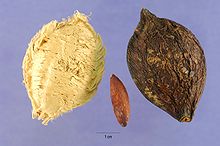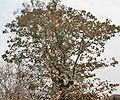- Terminalia catappa
-
Terminalia catappa 
Scientific classification Kingdom: Plantae Division: Magnoliophyta Class: Magnoliopsida Order: Myrtales Family: Combretaceae Genus: Terminalia Species: T. catappa Binomial name Terminalia catappa
L.Terminalia catappa is a large tropical tree in the Leadwood tree family, Combretaceae. The tree has been spread widely by humans and the native range is uncertain. It has long been naturalised in a broad belt extending from Africa to Northern Australia and New Guinea through Southeast Asia and Micronesia into the Indian Subcontinent. More recently the plant has been introduced to parts of the Americas. Common names include Bengal almond, Singapore almond, Ebelebo, Malabar almond, Indian almond, Tropical almond, Sea almond, Beach Almond, Talisay tree, Umbrella tree, Abrofo Nkatie (Akan), Tavola (Fiji), "Castanhola" (Northeastern Brazil), Zanmande (creole) and kotōl (Marshallese)[1].
It grows to 35 metres (115 ft) tall, with an upright, symmetrical crown and horizontal branches. The Terminalia catappa has corky, light fruit that is dispersed by water. The nut within the fruit is edible when fully ripe,tasting almost like almond. As the tree gets older, its crown becomes more flattened to form a spreading, vase shape. Its branches are distinctively arranged in tiers. The leaves are large, 15–25 centimetres (5.9–9.8 in) long and 10–14 centimetres (3.9–5.5 in) broad, ovoid, glossy dark green and leathery. They are dry-season deciduous; before falling, they turn pinkish-reddish or yellow-brown, due to pigments such as violaxanthin, lutein, and zeaxanthin.
The flowers are monoecious, with distinct male and female flowers on the same tree. Both are 1 centimetre (0.39 in) in diameter, white to greenish, inconspicuous with no petals; they are produced on axillary or terminal spikes. The fruit is a drupe 5–7 centimetres (2.0–2.8 in) long and 3–5.5 centimetres (1.2–2.2 in) broad, green at first, then yellow and finally red when ripe, containing a single seed.
Contents
Cultivation and uses
Terminalia catappa is widely grown in tropical regions of the world as an ornamental tree, grown for the deep shade its large leaves provide. The fruit is edible, tasting slightly acidic.
The wood is red, solid and has high water resistance; it has been utilized in Polynesia for making canoes. In Tamil, almond is known "Nattuvadumai".
The leaves contain several flavonoids (like kaempferol or quercetin), several tannins (such as punicalin, punicalagin or tercatin), saponines and phytosterols. Due to this chemical richness, the leaves (and also the bark) are used in different traditional medicines for various purposes. For instances, in Taiwan fallen leaves are used as a herb to treat liver diseases. In Suriname, a tea made from the leaves is prescribed against dysentery and diarrhea. It is also thought that the leaves contain agents for prevention of cancers (although they have no demonstrated anticarcinogenic properties) and antioxidant as well as anticlastogenic characteristics.Extracys of Terminalia catappa have shown activity against Plasmodium falciparum chloroquine (CQ)-resistant (FcB1) and CQ-sensitive (HB3) strains.[2]
Keeping the leaves in an aquarium is said to lower the pH and heavy metal content of the water[citation needed]. It has been utilized in this way by Betta breeders in Thailand for many years. It's also believed that it helps prevent fungus forming on the eggs of the fish.[citation needed]. Local hobbyists also use it for conditioning the betta's water for breeding and hardening of the scales[citation needed].
Gallery
-
in Hyderabad, India.
-
in Hyderabad, India.
-
in Hyderabad, India.
-
in Hyderabad, India.
-
in Hyderabad, India.
-
in Hyderabad, India.
-
trunk in Kolkata, West Bengal, India.
-
tree in Kolkata, West Bengal, India.
-
tree in Kolkata, West Bengal, India.
-
old trunk in Kolkata, West Bengal, India.
-
fallen leaf in Kolkata, West Bengal, India.
-
fallen leaf (back side) in Kolkata, West Bengal, India.
-
branches with new leaves & flower spikes in Kolkata, West Bengal, India.
References
- ^ Marshallese-English Dictionary
- ^ Hnawia E, Hassani L, Deharo E, Maurel S, Waikedre J, Cabalion P, Bourdy G, Valentin A, Jullian V, Fogliani B.,"Antiplasmodial activity of New Caledonia and Vanuatu traditional medicines". Pharm Biol. 2011 Apr;49(4):369-76
External links
- Indian almond leaves and their use in aquariums
- Indian almond leaves- Website devoted to Indian almond leaves in folk medicine, modern medicine and aquariums.
- More Ketapang Info- Blog on Ketapang Leaves
Categories:- Terminalia
- Flora of the Maldives
- Flora of Nicaragua
- Flora of Queensland
- Myrtales of Australia
- Naturalized trees of Hawaii
- Trees of Australia
- Flora of Samoa
- Flora of Christmas Island
-
Wikimedia Foundation. 2010.




















